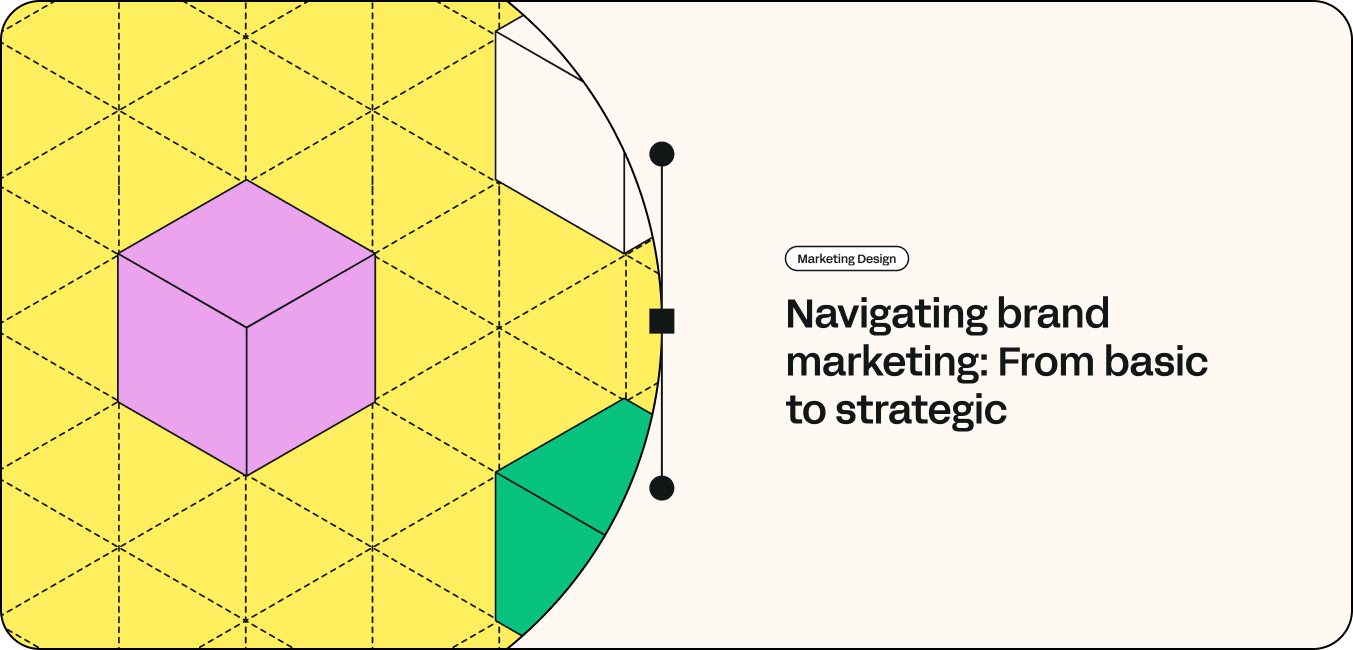Brand marketing is more than just a logo or catchy slogan. It's an evolving journey–from foundational concepts to nuanced strategies.
It's normal to feel overwhelmed initially, but taking the time to understand both the basic and more complex aspects of brand marketing will set you up for long-term success.
This guide offers a roadmap, taking you from the fundamental building blocks of brand marketing to harnessing the power of strategic savvy.
Jumpstart your ideas with Linearity Curve
Take your designs to the next level.
What’s brand marketing?
At its core, brand marketing is the process of promoting and positioning your brand in the market, differentiating it from competitors, and creating a lasting connection with your audience.
Marketing efforts in brand management involve creating a comprehensive marketing plan that encompasses various marketing channels and tactics.
One of the key elements of brand marketing is the creation of a distinct visual identity. This includes elements such as logos, colors, and design elements that help consumers easily recognize and remember your brand.
This cohesive visual identity across all marketing activities helps reinforce brand recognition and builds trust and loyalty among customers.
Customer experience plays a vital role in brand marketing.
An effective brand marketing strategy goes beyond short-term goals and focuses on long-term success. It involves setting clear marketing goals aligned with the overall business objectives and establishing key performance indicators (KPIs) to measure success.
Developing an effective brand marketing strategy requires a dedicated marketing team and a well-allocated marketing budget. A team of professionals with expertise in different areas of marketing can collaborate to create and execute impactful marketing campaigns. The allocated budget ensures that marketing activities can be carried out efficiently and effectively.
The benefits of brand marketing
By implementing effective brand marketing strategies, companies can increase their brand awareness and build strong and lasting relationships with their target customers.
Establishing a distinct identity
One of the key benefits of brand marketing is that it helps businesses establish a distinct identity in the minds of consumers.
A brand can differentiate itself from its competitors through consistent messaging and visual elements. This creates a strong and recognizable presence.
Building trust and credibility
Brand marketing also helps to build trust and credibility among consumers. When a business consistently delivers on its brand promises and provides an exceptional customer experience, it fosters customer loyalty and encourages repeat purchases.
Customers are more likely to choose a brand they trust over other alternatives, even if they are slightly more expensive or less conveniently located.
Connecting with ideal customers
Brand marketing allows businesses to connect with their ideal customers on a deeper level. By understanding their target audience and their needs and preferences, businesses can create targeted marketing campaigns that speak directly to their customer's pain points and desires.
This personalized approach enhances the overall customer experience and fosters a sense of loyalty and connection.
Premium pricing
Another significant benefit of brand marketing is the ability to command premium pricing. When a brand has successfully positioned itself as a leader in its industry and has built a reputable image, customers are often willing to pay a higher price for its products or services.
This premium pricing not only enhances the business's profitability but also positions it as a high-quality and desirable choice in the eyes of consumers.
Establishing a long-term competitive advantage
Brand marketing helps businesses establish a long-term competitive advantage. By investing in building a strong brand, companies create barriers to entry for potential competitors.
Customers become emotionally attached to the brand, making it difficult for new players to capture their attention and loyalty. This long-term advantage allows businesses to focus on growth and expansion rather than constantly defending their market position.
Diving deeper
When it comes to brand marketing, scratching the surface won't cut it. To truly make an impact and stand out in a crowded marketplace, you need to dive deeper and go beyond the usual marketing efforts.
Identifying your target audience
One of the first steps in diving deeper is understanding your target audience. Who does your target audience consist of? The specific group of people who are most likely to be interested in your products or services and are likelier to become your customers.
Elevate Your Branding with Linearity
Discover how Linearity can transform your branding strategy. Learn to create distinctive brand assets that resonate with your audience and stand out in the market.
By defining and reaching your target audience effectively, you can maximize the impact of your marketing efforts and ultimately drive more sales.
To determine your target audience, you need to consider various demographic and psychographic factors.
Demographic factors include:
- Age
- Gender
- Location
- Income level
- Occupation
Psychographic factors include:
- Values
- Interests
- Lifestyles
- Behaviors
By analyzing these factors, you can create buyer personas that represent your ideal customers, allowing you to tailor your marketing strategies to their specific needs and preferences.
Understanding your target audience also helps you craft the right marketing messages and use the most suitable marketing channels to reach them.
By knowing their pain points, desires, and motivations, you can create messaging that resonates with them and addresses their specific needs. This will make your marketing efforts more targeted and effective, increasing the chances of capturing their attention and driving them to take action.
Identifying your target audience enables you to choose the right marketing channels to engage with them. Whether it's social media platforms, email marketing, content marketing, or paid advertising, knowing where your target audience spends their time will allow you to reach them in the most relevant and impactful way.
Understanding your target audience also helps you allocate your marketing budget more effectively. By focusing your resources on reaching the specific group of people most likely to convert, you can avoid wasting money on ineffective marketing efforts.
This targeted approach allows you to maximize your return on investment and achieve better results with your marketing campaigns.
Creating a solid brand marketing strategy
A brand marketing strategy sets the foundation for all marketing efforts and helps achieve the long-term goals of the business.
Once you have identified your target audience, it is important to develop marketing strategies that effectively reach and resonate with them.
This involves determining the marketing channels and tactics that will be most effective in reaching and engaging your target customers. It may include a combination of social media posts, email marketing, content marketing, and advertising campaigns.
A solid brand marketing strategy also takes into consideration the customer experience. Creating a positive and memorable experience for customers at every touchpoint is crucial for building loyalty and advocacy.
Another key element of a solid brand marketing strategy is the visual identity. This includes the design elements and creative elements that represent your brand. Consistency in visual identity helps create recognition and establishes a distinct identity in the marketplace.
In addition to customer experience and visual identity, content marketing is a key element in diving deeper.
It is important to set measurable marketing goals and determine the KPIs that will be used to gauge the success of the strategy. This could include objectives such as increasing brand awareness, growing the customer base, or improving customer loyalty.
Creating a solid brand marketing strategy also requires allocating resources effectively. This involves determining the marketing budget and assembling a skilled and knowledgeable marketing team to execute the strategy.
A successful brand marketing strategy requires a team that is well-versed in the type of marketing being employed and has a deep understanding of the target audience.
Positioning and differentiation
Positioning and differentiation are essential components of a successful brand marketing strategy. In a crowded marketplace, it's crucial to stand out and make a lasting impression on your target audience. This is where positioning comes into play.
Positioning refers to how you position your brand in the minds of your customers. It's about creating a distinct identity and conveying a clear message about what makes your brand unique and valuable. When considering your positioning strategy, it's important to understand your target customer and what they value most.
To effectively position your brand, you must identify your unique selling proposition (USP). These are the features or benefits that set your brand apart from competitors. Whether it's superior quality, exceptional customer service, or innovative solutions, your USPs should resonate with your target market and align with their needs and preferences.
Differentiation, on the other hand, refers to how your brand sets itself apart from competitors in the market. It involves identifying and highlighting key points of difference that make your brand the better choice. This can be achieved through various means, such as product features, pricing strategies, customer experience, or marketing communication.
Effective differentiation requires a deep understanding of your target market's pain points and desires.
By addressing their specific needs and offering a unique value proposition, you can position your brand as the preferred choice amongst the competition. It's important to consistently communicate these points of differentiation across all marketing channels to maintain a cohesive and impactful brand message.
One common form of differentiation is through the use of a distinct visual identity. This includes your logo, color palette, typography, and overall design elements. A visually appealing and cohesive brand identity helps you stand out visually and plays a vital role in creating brand recognition and recall.
Ready to
create brand assets
that pack a punch?
Visit our Academy for free marketing
design courses.
Another way to differentiate your brand is by focusing on customer experience.
A positive customer experience can lead to increased loyalty, word-of-mouth referrals, and ultimately, a stronger brand reputation.
Differentiation and positioning go hand in hand, working together to create a unique and compelling brand identity. By effectively positioning your brand and highlighting points of differentiation, you can attract your ideal customers, build trust and loyalty, and ultimately achieve long-term success in a competitive marketplace.
Emotional connection
In today's competitive marketplace, building a strong brand requires more than just a catchy slogan or a visually appealing logo. It requires establishing an emotional connection with your target audience.
Why?
Because human beings are emotional creatures, and our purchasing decisions are often influenced by how a brand makes us feel.
When done successfully, this emotional connection can create a bond of loyalty and trust that goes beyond mere transactions.
So, how can you effectively establish an emotional connection with your target audience? Here are a few strategies to consider:
1. Tell compelling stories: Humans have been storytelling creatures for thousands of years, and stories have a unique power to evoke emotions. Use storytelling techniques to share narratives that reflect your brand values, showcase your customers' experiences, or demonstrate the impact your products or services have had on their lives.
2. Be authentic: Today's consumers crave authenticity. They can spot inauthenticity from a mile away, and it can quickly erode trust. Be transparent, genuine, and true to your brand's values in all your communications and interactions. Show your human side, admit mistakes, and actively engage with your audience.
3. Create meaningful experiences: Instead of focusing solely on selling products or services, strive to create experiences that make a difference in your customers' lives. Offer personalized interactions, provide exceptional customer service, and go the extra mile to exceed their expectations. These meaningful experiences will leave a lasting impact and strengthen the emotional connection with your brand.
4. Tailor your messaging: Understand the unique pain points and aspirations of your target audience, and tailor your messaging to address those emotions. Use language, visual cues, and tone that resonate with their emotions. Show empathy and understanding, and position your brand as the solution to their needs.
5. Build a community: People are naturally drawn to communities where they feel a sense of belonging and connection. Create spaces, both online and offline, where your audience can come together, share their experiences, and connect with like-minded individuals. Foster a sense of community and make your audience feel valued and heard.
Remember, building an emotional connection doesn't happen overnight. It requires consistent effort, understanding, and ongoing engagement with your audience.
Engagement channels
In today's digitally-driven world, brands have numerous channels at their disposal to engage with their target audience. These engagement channels provide opportunities to build meaningful relationships, foster brand loyalty, and ultimately, drive business growth.
Let’s explore some of the most effective engagement channels and how they can be leveraged to connect with your target audience.
Social media platforms
Social media has revolutionized the way brands interact with their customers. Platforms such as Facebook, Instagram, Twitter, and LinkedIn provide an avenue to engage in real-time conversations, share content, and build a community around your brand.
Get creative
with our ready-to-use templates
Linearity Curve offers templates for every
social media platform and various
print and digital projects.
Email marketing
Email marketing is a tried and true channel for nurturing relationships with your target audience. It enables you to deliver customized and tailored messages directly to your customers' inboxes.
Want to keep your brand top-of-mind, drive repeat business, and encourage customer loyalty? We suggest providing valuable content, exclusive promotions, and personalized recommendations.
Online communities and forums
Engaging in online communities and forums that align with your brand values and target audience can be an effective way to establish credibility and build trust.
By participating in industry-specific discussions, offering helpful insights, and answering questions, you can position yourself as an authority and gain visibility within your target market. Additionally, these communities can provide valuable feedback and insights that can inform your marketing strategy and improve customer experience.
In-person events and workshops
While digital channels dominate today's marketing landscape, in-person events and workshops should not be overlooked.
Customer feedback and surveys
By regularly conducting surveys and soliciting feedback, you not only make your customers feel valued and heard, but you also gain valuable insights into their preferences, pain points, and expectations. This feedback can help shape your marketing strategies and drive continuous improvement.
Achieving strategy savviness
Being strategy savvy means thinking critically, making informed decisions, and aligning actions with long-term goals. Regarding brand marketing, strategic savviness is essential for crafting effective marketing strategies that resonate with the target audience and drive tangible results.
It also involves keeping a close eye on the competitive marketplace. By keeping tabs on your competitors' marketing strategies and efforts, you can identify potential opportunities or threats.
Data-driven decision-making
By harnessing the power of data, brands can make informed and strategic choices that resonate with their target audience.
From identifying patterns and personalizing marketing efforts to optimizing strategies and maximizing ROI, data-driven decision-making is an integral part of any successful brand marketing strategy.
Continuous evolution
Brands must constantly evaluate their marketing strategies, stay connected to their target audience, prioritize customer experience, and embrace technology and data-driven decision-making.
Influencer partnerships
By partnering with influencers, brands can reach a larger audience, bring a fresh perspective to their marketing efforts, leverage social media, and build credibility. Influencer partnerships have already become an integral part of brand marketing strategies.
Integrated marketing
Integrated marketing is a powerful strategy that can help brands create a consistent and impactful brand experience across various marketing channels and tactics.
When aligning messaging, visuals, and customer experience, brands can build a solid and distinct brand identity, maximize reach and engagement, amplify marketing efforts, and track and measure success.
What’s next?
Navigating the world of brand marketing is a step towards effective communication with your audience and potential customers.
And understanding the intricate layers of brand marketing is a continuous, rewarding learning process. So we suggest continuing to explore and refine your approach to navigate the path from basics to strategic savvy successfully.
To take your brand marketing strategy to the next level, take a look at our templates and assets and get started with Linearity Curve.
Jumpstart your ideas with Linearity Curve
Take your designs to the next level.
Be one of the first designers to try Linearity Move, our new animation tool for making marketing motion graphics quickly and easily. Join the waitlist to get access.


Share this!
Juxhina Malaj
Juxhina is a contributing writer to the Linearity Blog.


:quality(75))
:quality(75))



:quality(75))






